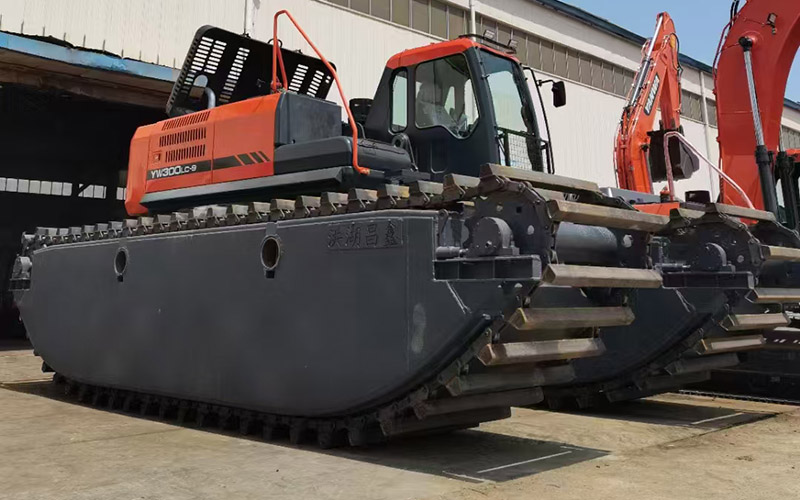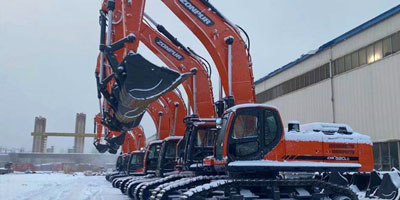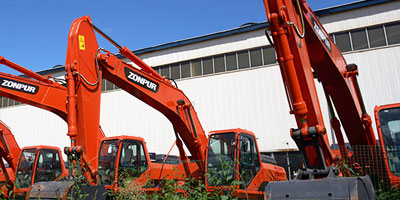Hydraulic system faults in excavators can affect their normal operation. The following is a detailed introduction to common causes and troubleshooting methods:
Common reasons
Hydraulic oil problem
Pollution: During the use of hydraulic oil, impurities such as moisture, dust, and metal shavings may be mixed in. These pollutants can accelerate the wear of hydraulic components, block throttle holes and crevice valve ports, and cause abnormal operation of hydraulic systems.
Deterioration: Long term high temperature, oxidation and other factors can cause changes in the performance of hydraulic oil, such as decreased viscosity and wear resistance, thereby affecting the normal operation of hydraulic systems.
Insufficient oil level: Insufficient hydraulic oil can lead to insufficient system pressure, which cannot provide enough power to drive hydraulic components.
Hydraulic pump malfunction
Wear and tear: The gears, blades, plungers, and other components inside the hydraulic pump will experience wear and tear during long-term operation, resulting in a decrease in the pump's volumetric efficiency, reduced output flow rate, and insufficient system pressure.
Poor oil suction: Blocked oil suction pipes, clogged oil filters, or excessively high suction heights can all cause difficulty in hydraulic pump suction, resulting in unstable or no system pressure.
Seal damage: Damaged seals of hydraulic pumps can cause leaks, making it impossible to establish or maintain stable system pressure.
Control valve malfunction
Stuck of valve core: During long-term use, the valve core of the control valve may be stuck in a certain position due to impurities entering, spring deformation, etc., causing hydraulic oil to not flow normally and affecting the normal operation of the system.
Spring damage: The spring in the control valve plays a role in regulating pressure and flow. If the spring is damaged, it can cause the system pressure and flow to lose control.
Electromagnetic coil failure: For electrically controlled valves such as electromagnetic directional valves, electromagnetic coil failure can cause the valve to fail to reverse direction properly, affecting the operation of the hydraulic system.
Hydraulic cylinder malfunction
Internal leakage: The wear or damage of the piston seal of the hydraulic cylinder can cause hydraulic oil to leak inside the cylinder, making it impossible for the hydraulic cylinder to maintain stable working pressure, resulting in slow and weak movements.
Leakage: Damage to the end cover seal of the hydraulic cylinder or loosening of the oil pipe joint can cause hydraulic oil to leak to the outside, which not only leads to insufficient system pressure but also pollutes the working environment.
Piston rod deformation: When the piston rod is impacted by external forces or subjected to long-term eccentric loads, it may deform and affect the normal operation of the hydraulic cylinder.
Oil temperature too high
Poor heat dissipation: Blockage of the radiator, malfunction of the cooling fan, and other reasons can lead to a decrease in the heat dissipation effect of the hydraulic system and an increase in oil temperature.
Excessive system pressure: Excessive system pressure can increase the power loss of hydraulic oil, generate too much heat, and cause the oil temperature to rise.
Inappropriate viscosity of hydraulic oil: If the viscosity of the hydraulic oil used is too high, the flow resistance in the system will increase, which will generate more heat; If the viscosity is too low, it will cause an increase in leakage and also raise the oil temperature.
Troubleshooting methods
Visual inspection method
Observation of appearance: Check for obvious damage, deformation, leakage, and other conditions in the hydraulic system components, such as whether the oil pipes are broken, whether the joints are loose, and whether there is oil leakage in the oil tank.
Check the oil level: Check if the oil level in the hydraulic oil tank is within the normal range. If the oil level is too low, add hydraulic oil in a timely manner.
Check oil quality: Determine whether the oil quality is good by observing the color, transparency, and odor of the hydraulic oil. Normal hydraulic oil should be clear, transparent, and odorless; If the oil color turns black, cloudy, or has a pungent odor, it indicates that the oil quality has deteriorated and needs to be replaced.
Stress testing method
Use pressure gauges: Install pressure gauges at key parts of the hydraulic system, such as the pump outlet, control valve inlet and outlet, rodless and rodless chambers of the hydraulic cylinder, etc., measure the pressure values of the system under different operating conditions, and compare them with the rated pressure of the equipment. If the pressure value does not meet the requirements, it indicates that there is a malfunction in the system.
Analyze pressure changes: Observe the pressure changes on the pressure gauge and determine the approximate location of the malfunction. For example, if the system pressure cannot increase continuously, it may be due to a hydraulic pump failure or a low set pressure of the relief valve; If there is a large pressure fluctuation, it may be due to the control valve spool being stuck or the hydraulic cylinder leaking.
Traffic testing method
Use flow meter: Determine the working performance of hydraulic pumps and control valves by measuring the flow rate of the hydraulic system. If the flow rate is lower than the rated value, it may be caused by wear of the hydraulic pump, poor oil suction, or blockage of the control valve throttle.
Observe the operating speed of the actuator: Check if the operating speed of the hydraulic cylinder or hydraulic motor is normal. If the action speed is too slow, in addition to considering insufficient traffic, it may also be caused by excessive load or system leakage.
Substitution method
Replace suspicious components: When a hydraulic component is suspected to be faulty, it can be replaced with a known good component of the same model, and then the system's operation can be observed. If the fault disappears, it indicates that there is a problem with the replaced component; If the fault still exists, it is necessary to continue troubleshooting other parts.
Functional testing method
Simulated working condition testing: Based on the working characteristics of the excavator, simulate different working conditions for testing, such as excavation, lifting, rotation, etc., observe the performance of the system under different working conditions, and identify the specific links where faults occur.
Segmented inspection: Divide the hydraulic system into several parts, inspect and test each section, gradually narrow down the scope of the fault, and ultimately determine the location of the fault. For example, you can first check the hydraulic pump and its suction circuit, and then check the control valve and hydraulic cylinder, etc.



 +8613356922335
+8613356922335








